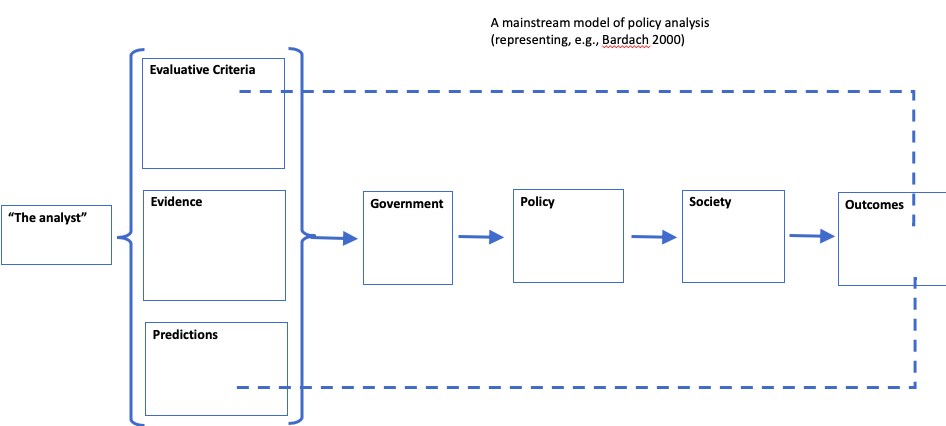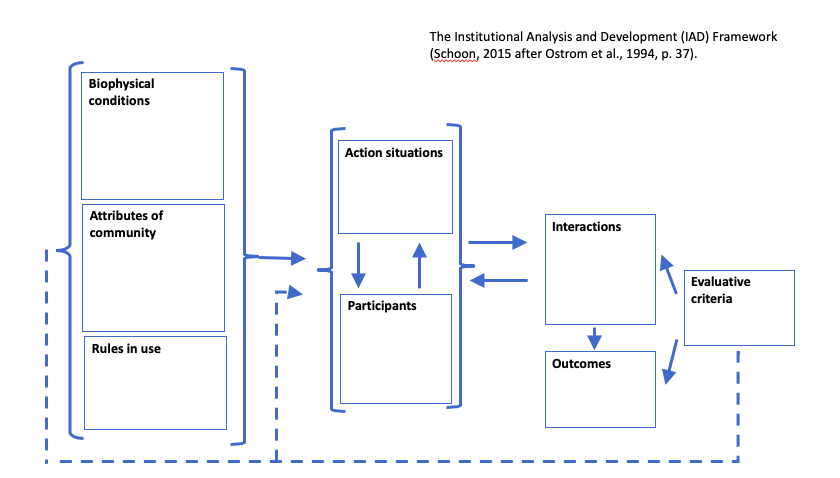- Facebook102
- Threads
- Bluesky
- Total 102
Here is a rather standard model for policy analysis, representing the content of a fairly typical public policy course or a textbook such as Eugene Bardach’s A Practical Guide for Policy Analysis (2000).

The analyst is a professional: a staffer, a consultant, or possibly an elected official. This person assembles evidence, combines it with evaluative criteria (e.g., fairness or efficiency) and makes predictions. The result is advice, probably in the form of a memo or slide deck. Methods for reaching conclusions may include, among others, cost/benefit analysis or sensitivity analysis.
The recipient is an authority: a decision-maker within a government or perhaps someone whose role is like a government’s, e.g., a corporate executive who sets internal policies. Influenced by the analyst, the authority makes policy, which takes the form of taxes or fees, prohibitions and penalties, authorizations, subsidies and rewards, licenses, personnel deployments, etc.
In turn, the policy influences “society.” That is a complex amalgam, but a major component of society is a set of markets that can be affected by governmental policy. As a result of the society’s own dynamics, plus the government’s policy intervention, certain outcomes arise. The analyst had tried both to predict and assess those outcomes (hence the dotted lines), and did a good job if the outcomes turn out to be good.
In contrast, here is the model of Institutional Analysis and Development (IAD) developed by Elinor Ostrom and colleagues. I have explained it in more detail before.

To some extent, these two models can be reconciled. For instance, the analyst in the first model collects evidence, some which may be about biophysical conditions (Which medicines work on which diseases?), attributes of community (How equal are people in the population?) and “rules-in-use” (What actual laws and/or norms are people observed to follow?). Evaluative criteria appear in both models.
But the models also differ in some important ways.
Where is the analyst in Ostrom’s model? Perhaps it is anyone who can observe and analyze the institution, including participants in it. In fact, analysts always work within institutions, with their own biophysical conditions, attributes of community, etc.
The first model treats “government” as the major actor, whereas the second sees institutions all over the place. According to Ostrom et al., a government is a set of institutions, but so is the analyst’s agency, the market they’re considering regulating, and even the discussions that generate the evaluative criteria. Whereas the first model is linear–from the analyst to the outcome–the second one is deeply recursive.
Here are some questions to ask about either model, or about any model for analyzing policy:
What is the value of analysis? Specifically, what is the value of relatively professional and trained, yet not hyper-specialized, analysis? What does an analyst know that immersed participants don’t know? What can someone with an MPP contribute?
How should we think about time? In the first model, the whole point is the future. As business school students learn, it’s rational to ignore sunk costs. The only questions are: What will happen if we act in a given way, and is it good? The second model is arguably static, a map of how an institution functions at time-T. But where did it come from? What would change it into an entirely different institution? And for both models: should the past matter?
Whose responsibility is it to decide? Perhaps a “decision-maker” inevitably decides, even if it’s in favor of the status quo. Then perhaps people who are decision-makers should learn to have a mental bias in favor of making decisions and taking responsibility for them. But do you or I have a moral responsibility to be decision-makers?
What is the place of markets in all of this? For Bardach (pp. 4-5) they seem to be the default social form, and governments intervene in them if and when they fail in various ways. Governments, in turn, are not markets: they regulate or affect markets. For Ostrom et al., all institutions involve distinct participants who interact to produce outcomes. Markets involve a certain range of interactions (bargaining, exchange, but also discussion, persuasion, collaboration, and exit). So do other institutions, including governments. There is no sharp difference between a market and a government (or a church, or a scientific discipline, or an online network). The differences are the details in the boxes above.
What is the role of the public, citizens, and public discussions? These are not mentioned in either diagram. For Bardach, citizens emerge as audiences and sometimes as sources of political constraint. The analyst should consider public opinion because it’s too hard to implement advice that is deeply unpopular in a democracy. Those are narrow roles for the public. In Ostrom, everyone is part of a complex, dynamic system. That means there are no sharp distinctions among policy-makers, analysts, and citizens. They all make policy in various ways. But should there be a special role for citizens, as such? And can policy promote that role?
See also a template for analyzing an institution; polycentricity: the case for a (very) mixed economy; syllabus of a public policy course; and avoiding a sharp distinction between the state and the private sphere
